Related Research Articles

The Tortricidae are a family of moths, commonly known as tortrix moths or leafroller moths, in the order Lepidoptera. This large family has over 11,000 species described, and is the sole member of the superfamily Tortricoidea, although the genus Heliocosma is sometimes placed within this superfamily. Many of these are economically important pests. Olethreutidae is a junior synonym. The typical resting posture is with the wings folded back, producing a rather rounded profile.

Tortrix is a genus of moths belonging to the family Tortricidae.

The Archipini are a tribe of tortrix moths. Since many genera of these are not yet assigned to tribes, the genus list presented here is provisional.

Syndemis musculana is a moth of the family Tortricidae. It is found in Europe, China, the Korean Peninsula, Japan, Russia (Amur) and North America.

Clepsis spectrana, the cyclamen tortrix, cabbage leafroller or straw-colored tortrix, is a moth of the family Tortricidae. It is found in Europe.
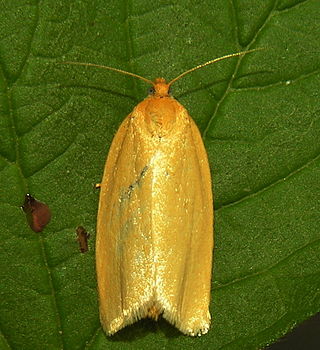
Aphelia paleana, the timothy tortrix, is a moth of the family Tortricidae. It is found in Europe, and across the Palearctic to China and the Russian Far East.
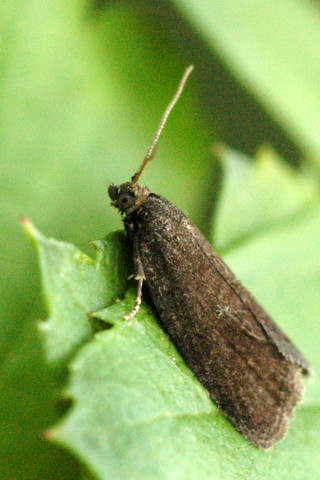
Aphelia viburnana, the bilberry tortrix, is a moth of the family Tortricidae. It is found in Europe, from Portugal and Great Britain to the Ural Mountains, Siberia and Mongolia, further east to the Russian Far East.

Hedya nubiferana, the marbled orchard tortrix or green budworm moth, is a moth of the family Tortricidae. It is found in the Palearctic and Nearctic realms.

Archips rosana, the rose tortrix, is a moth of the family Tortricidae. It is found in both the Palearctic and Nearctic realms.
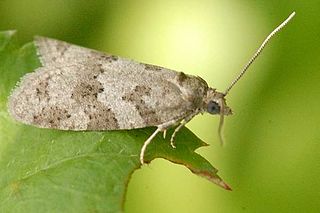
Cnephasia stephensiana, the grey tortrix, is a moth of the family Tortricidae. It is found in the Palearctic realm, and has also been recorded from Canada.

Cnephasia incertana, the light grey tortrix, is a moth of the family Tortricidae. It is found all over Europe.
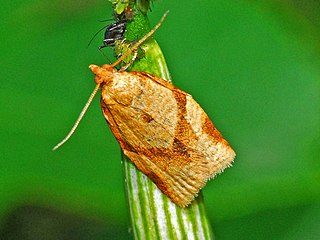
Clepsis consimilana, the privet tortrix, is a moth of the family Tortricidae.

Celypha aurofasciana is a small moth species of the family Tortricidae. It is native to Europe and the Palearctic but occurs in some other places as an introduced species.

Rhopobota naevana, the holly tortrix moth, holly leaf tier or blackheaded fireworm, is a moth of the family Tortricidae. It is found from Europe to eastern Russia, China, Taiwan, Mongolia, Korea and Japan. It is also present in India, Sri Lanka and North America.
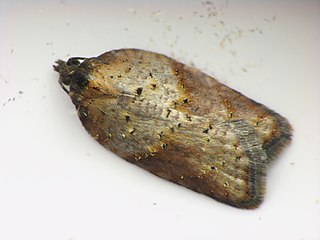
The Tortricini are a tribe of tortrix moths.

Clepsis senecionana, the rustic tortrix, is a moth of the family Tortricidae. It is found from Europe to eastern Siberia.

Pandemis corylana, the chequered fruit-tree tortrix, hazel tortrix moth, filbert tortricid or barred fruit tree moth, is a moth of the family Tortricidae. It is found from northern and central Europe to Siberia, Korea and Japan.
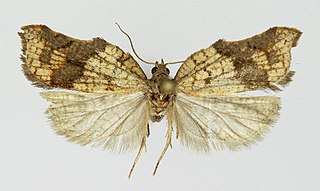
Acleris effractana, the hook-winged tortrix moth, is a moth of the family Tortricidae. It was described by Jacob Hübner in 1799. It has a Holarctic distribution. In Europe, it is found from northern Europe to the northern part of central Europe. It is also present in north-western Russia, Japan, Canada and the northwestern United States.
"Tortrix" celatrix is a species of moth of the family Tortricidae. It is found in Australia, where it has been recorded from Queensland.

Planotortrix notophaea, the blacklegged leafroller, is a species of moth in the family Tortricidae. It is endemic to New Zealand. It was also present near Sydney in Australia, but this population is thought to be extinct.
References
- ↑ New Australian Lepidoptera of the Family Tortricidae
 This article incorporates text from this source, which is in the public domain .
This article incorporates text from this source, which is in the public domain .